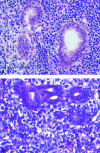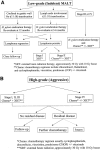The diminishing role of surgery in the treatment of gastric lymphoma
- PMID: 15213615
- PMCID: PMC1356371
- DOI: 10.1097/01.sla.0000129356.81281.0c
The diminishing role of surgery in the treatment of gastric lymphoma
Abstract
Objective: This article reviews the pathogenesis, diagnosis, and treatment of patients with primary gastric lymphoma, with special attention to the changing role of surgery.
Summary background data: Primary gastric lymphomas are non-Hodgkin lymphomas that originate in the stomach and are divided into low-grade (or indolent) and high-grade (or aggressive) types. Low-grade lesions nearly always arise from mucosa-associated lymphoid tissue (MALT) secondary to chronic Helicobacter pylori (H. pylori) infection and disseminate slowly. High-grade lesions may arise from a low grade-MALT component or arise de novo and can spread to lymph nodes, adjacent organs and tissues, or distant sites.
Methods: A review of the relevant English-language articles was performed on the basis of a MEDLINE search from January 1984 to August 2003.
Results: About 40% of gastric lymphomas are low-grade, and nearly all these low-grade lesions are classified as MALT lymphomas. For low-grade MALT lymphomas confined to the gastric wall and without certain negative prognostic factors, H. pylori eradication is highly successful in causing lymphoma regression. More advanced low-grade lymphomas or those that do not regress with antibiotic therapy can be treated with combinations of H. pylori eradication, radiation therapy, and chemotherapy. Nearly 60% of gastric lymphomas are high-grade lesions with or without a low-grade MALT component. These lymphomas can be treated with chemotherapy and radiation therapy according to the extent of disease. Surgery for gastric lymphoma is now often reserved for patients with localized, residual disease after nonsurgical therapy or for rare patients with complications.
Conclusion: The treatment of gastric lymphoma continues to evolve, and surgical resection is now uncommonly a part of the initial management strategy.
Figures



Similar articles
-
Helicobacter pylori-negative gastric mucosa-associated lymphoid tissue lymphomas: A review.World J Gastroenterol. 2015 Jul 14;21(26):8014-20. doi: 10.3748/wjg.v21.i26.8014. World J Gastroenterol. 2015. PMID: 26185372 Free PMC article. Review.
-
Malignant tumors of the stomach. Gastric mucosa-associated lymphoid tissue lymphoma and Helicobacter pylori.Gastroenterol Clin North Am. 2000 Sep;29(3):593-607. doi: 10.1016/s0889-8553(05)70132-1. Gastroenterol Clin North Am. 2000. PMID: 11030075 Review.
-
Helicobacter pylori eradication therapy in gastric high grade non Hodgkin's lymphoma (NHL).Ann Hematol. 2001;80 Suppl 3:B106-7. doi: 10.1007/pl00022770. Ann Hematol. 2001. PMID: 11757689 Clinical Trial.
-
Treatment of gastric mucosa-associated lymphoid tissue lymphoma: Helicobacter pylori eradication and beyond.Expert Rev Anticancer Ther. 2006 Mar;6(3):361-71. doi: 10.1586/14737140.6.3.361. Expert Rev Anticancer Ther. 2006. PMID: 16503853 Review.
-
Recent developments in our understanding of gastric lymphomas.Am J Surg Pathol. 1996;20 Suppl 1:S1-7. doi: 10.1097/00000478-199600001-00002. Am J Surg Pathol. 1996. PMID: 8694145 Review.
Cited by
-
Synchronous Gastric Carcinoma and Nodal Malignant Lymphoma: A Rare Case Report and Literature Review.Case Rep Oncol. 2010 Jul 10;3(2):223-230. doi: 10.1159/000317603. Case Rep Oncol. 2010. PMID: 20740201 Free PMC article.
-
Favorable radiation field decrease in gastric marginal zone lymphoma : Experience of the German Study Group on Gastrointestinal Lymphoma (DSGL).Strahlenther Onkol. 2019 Jun;195(6):544-557. doi: 10.1007/s00066-019-01446-5. Epub 2019 Mar 11. Strahlenther Onkol. 2019. PMID: 30859254 English.
-
Gastrointestinal lymphomas: Morphology, immunophenotype and molecular features.J Gastrointest Oncol. 2012 Sep;3(3):209-25. doi: 10.3978/j.issn.2078-6891.2012.024. J Gastrointest Oncol. 2012. PMID: 22943012 Free PMC article.
-
Radiotherapy for localized gastric mucosa-associated lymphoid tissue lymphoma: long-term outcomes over 10 years.J Radiat Res. 2017 Jul 1;58(4):537-542. doi: 10.1093/jrr/rrw044. J Radiat Res. 2017. PMID: 28077625 Free PMC article.
-
Development of Organ-Preserving Radiation Therapy in Gastric Marginal Zone Lymphoma.Cancers (Basel). 2022 Feb 10;14(4):873. doi: 10.3390/cancers14040873. Cancers (Basel). 2022. PMID: 35205623 Free PMC article. Review.
References
-
- Stolte M. Helicobacter pylori gastritis and gastric MALT-lymphoma. Lancet. 1992;339:745–746. - PubMed
-
- Schechter NR, Portlock CS, Yahalom J. Treatment of mucosa-associated lymphoid tissue lymphoma of the stomach with radiation alone. J Clin Oncol. 1998;16:1916–1921. - PubMed
-
- Koch P, del Valle F, Berdel WE, et al. Primary gastrointestinal non-Hodgkin's lymphoma: II. Combined surgical and conservative or conservative management only in localized gastric lymphoma–results of the prospective German Multicenter Study GIT NHL 01/92. J Clin Oncol. 2001;19:3874–3883. - PubMed
-
- Jemal A, Thomas A, Murray T, et al. Cancer statistics, 2002. CA Cancer J Clin. 2002;52:23–47. - PubMed
-
- D'Amore F, Brincker H, Gronbaek K, et al. Non-Hodgkin's lymphoma of the gastrointestinal tract: a population-based analysis of incidence, geographic distribution, clinicopathologic presentation features, and prognosis. Danish Lymphoma Study Group. J Clin Oncol. 1994;12:1673–1684. - PubMed
Publication types
MeSH terms
LinkOut - more resources
Full Text Sources
Medical

